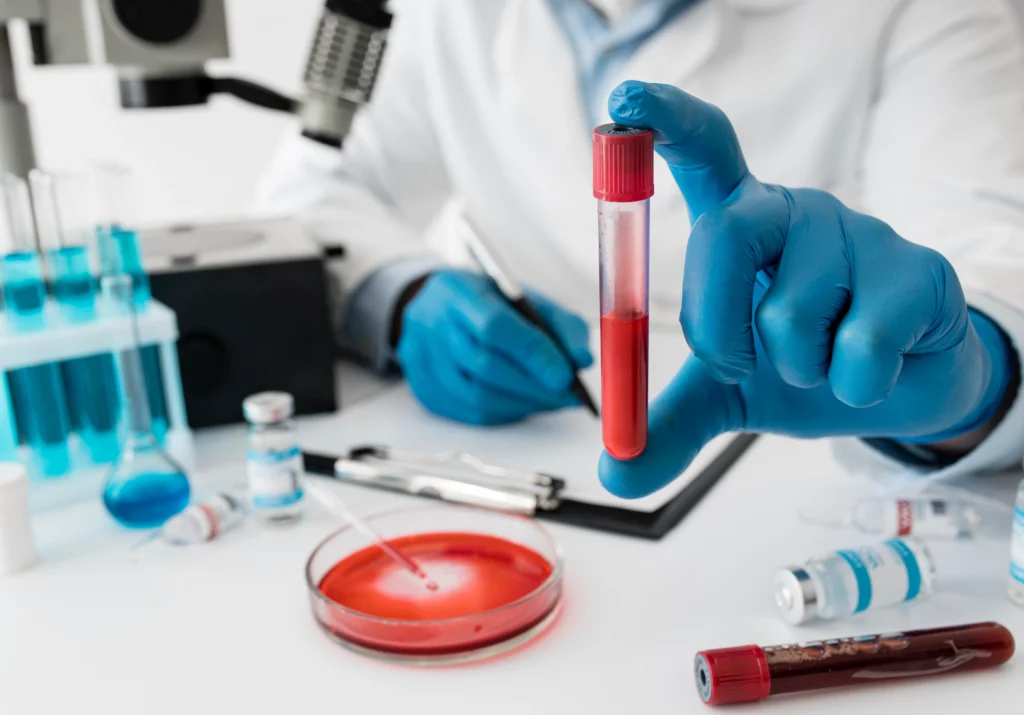Biochemistry
Introduction
Biochemistry
BLOOD COLLECTION AND BLOOD TEST
Blood tests are recommended to be conducted for preventive purposes once a year until one is 50, after that, every six months. Different metabolic and other disorders that occur in the body may be detected in blood tests. Everybody has its own specific enzymes, proteins or other organic molecules. As the blood system passes through all the organs, provides food to the cells and eliminates unnecessary and harmful products of the metabolism, any change in an organ(s) will be reflected in the blood circulation with the change in the concentration of enzymes, proteins, electrolytes, etc.
BIOCHEMICAL ANALYSIS AND BLOOD EXAMINATION
After collecting blood in different tubes with or without anticoagulant (e.g. the blood count requires EDTA anticoagulant, whereas most biochemical analysis need blood coagulation to obtain serum on which most analyses are conducted), blood/serum is analysed in different machines depending on the group of analyses. The main metabolic parameters (glucose, fats, proteins, enzymes) are determined with biochemistry analyzers which operate on the principle of photometry/spectrophotometry, while hormones and tumor markers are determined with immunochemistry analyzers. Their determination is mostly based on At-Ag reactions. The blood count with a differential leukocyte formula is determined with hematology analyzers, whose operation is based on different principles (ranging from potentiometry to flow cytometry, etc.) Most biochemistry analyses in Beo-lab are conducted with the most advanced integrated biochemistry autoanalyzer by ABBOTT company.
BLOOD COUNT ANALYSIS
A complete blood count analysis most often implies the blood count performed on the hematology analyzer. Today there are different hematology analyzers with at least 8 parameters to more than 20 parameters in the blood count analysis. To gain a general overview and control of the blood count, it is sufficient to conduct an analysis on the hematology analyzer with 8 parameters. Anemia or other hematological diseases require a hematological analyzer with more than 8 parameters.
INTERPRETATION OF LABORATORY AND BIOCHEMICAL BLOOD FINDINGS (RESULTS)
Interpretation of biochemical findings at a personal request will be provided by a Beo-lab specialist. Interpretation of biochemical results is a responsible and complex obligation of a specialist, and it requires a detailed analysis of every pathological finding.
BLOOD COUNT INTERPRETATION
Blood count interpretation, also at a personal request of the patient, will be provided by Beo-lab specialists. Blood count results reflect the number of blood cells in the bone marrow, and their ratio in blood circulation. The number of blood cells (leukocytes, erythrocytes and platelets) as well as the concentration of hemoglobin, hematocrit and other blood count parameters affect interpretation of the blood count.
Treatment
- A basic metabolic panel measures sodium, potassium, chloride, bicarbonate, blood urea nitrogen (BUN), magnesium, creatinine, glucose, and sometimes calcium. Tests focusing on cholesterol levels can determine LDL and HDL cholesterol levels, as well as triglyceride levels.
- Some tests, such as those that measure glucose or a lipid profile, require fasting (or no food consumption) eight to twelve hours prior to the drawing of the blood sample.
- For the majority of tests, blood is usually obtained from the patient’s vein. Other specialized tests, such as the arterial blood gas test, require blood extracted from an artery. Blood gas analysis of arterial blood is primarily used to monitor carbon dioxide and oxygen levels related to pulmonary function, but is also used to measure blood pH and bicarbonate levels for certain metabolic conditions.



